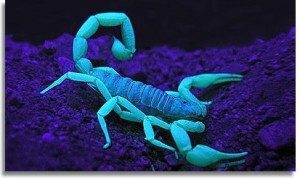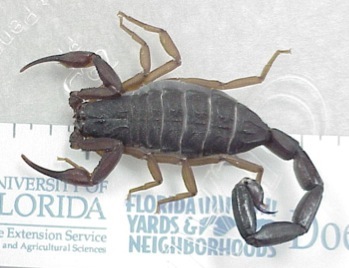
Florida Bark Scorpion
Southern Fried Scorpions
If I were going to rely on scorpions in Florida for sustenance, I would starve to death.
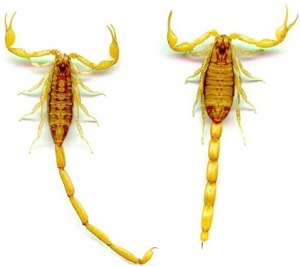
Guiana Striped Scorpion
In over 30 years of rummaging around the wild of Florida I have seen scorpions exactly three times, twice under domestic conditions. Once while living in Titusville there was one on my sink next to the soap dish, not much bigger than a cockroach. (This was the same apartment complex where I saw two rattle snakes up close and personal. I’ve only seen one rattler in the wild.)
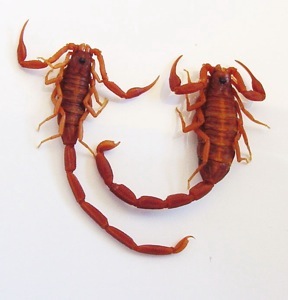
Heinz Scorpion
The next scorpion sighting was also in Titusville at a statuary store outside. I moved a small statute and a half a dozen little ones scurried away. Only once on the trail have I run into a scorpion. I was near Lake Tarpon in 2010 giving a class and talking about pines when a student pulled off some bark and found a very tiny scorpion, a Florida Bark Scorpion, Centruroides gracilis, which grows up to four inches long. Non-deadly, but painful and most painful of the local three (or four) scorpions. If stung while in gastronomical pursuit clean the site with soap and water and hold an ice pack against it to reduce swelling. (Others say run as hot a water as you can stand over it for 10 minutes. Choose your poison, so to speak.)
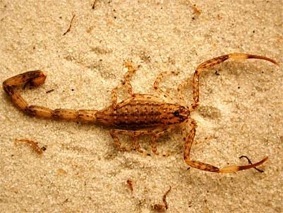
Asian House Scorpion
Other scorpio contenders in Florida are the Hentzi Scorpion (Centruroides hentzi) the most common and smallest, up to two inches. And the Guiana Striped Scorpion (Centruroides guianensis) the middle-weight, up to three inches.
The problem is the one I saw in my apartment some 30 years ago didn’t look like any of those three. Perhaps it was the Isometrus maculatus, selectively imported from Asia and called the House Scorpion. It is usually found in port cities. Titusville is not exactly a port city but is on the inter-coastal boat route.
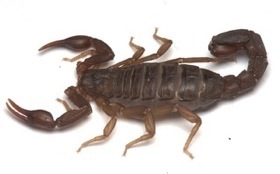
Vaejovis carolinianus also lives east of the Mississippi River but not in Florida
The Guiana Striped Scorpion is supposed to be in only Collier, Miami-Dade and Monroe counties, including the Keys. However there are unofficial reports of it in Pasco County. Hentz is the most common but is not found in the lower Keys. The Florida Bark Scorpion is widespread but mostly in the lower two thirds of the state. The only other scorpion east of the Mississippi is the Vaejovis carolinianus, which tends to reside in other southern states. In the United States, there are 90 or so species of scorpions. Only one in the desert southwest is considered life-threatening if stung.
Florida scorpions should be edible but I have not run across enough to give them a try. I suspect if one goes looking for them they are easier to find. If they are like most scorpions they are edible, usually cooked. However, do not eat them if you are allergic to seafood. They are related to crabs, lobsters and shrimp.
About the stinger. The Chinese maintain that if the stinger is cooked the poison is weakened but even then they caution not to eat more than five at a time. They view the cooked stinger more as medicine than food. From a culinary point of view, remove the stinger before or after cooking. Or at any rate don’t eat it unless you know something about the toxin and Chinese medicine.
As for glowing under Ultra Violet light, upper left, no one knows why scorpions glow in UV light. Let’s think this thing through. Flowers look different under UV light because it confers some advantage. In their case being found by insects. So what are the possibilities? Scorpions glow to help scorpions find scorpions, or glwo to help insects see them, either to avoid or find. Or perhaps it is the same as flowers: The scorpion glows under UV light, the insect is attracted, and the insect is the scorpion’s dinner. To our eyes the scorpion only looks different when in the dark and lighted by UV rays. In daylight the scorpion could look much different to an insect, just as flowers do. The only question I would have is whether that a difference is an attraction or a warning. Oh, scorpions are cannibalistic, and can live three to five years.
Deep fried scorpions are the most common way they are served. They are stuck on a skewer and plunged into hot oil. At home you might want to freeze them first, snip off the stingers, then fry.
Scientifically, Centruroides (sen-true-ROY-dez) is Dead Latin’s bastardized Greek meaning sharp-ended tail-like. Hmmmm. Not too inventive there. Gracilis (GRAS-il-is) is slender or graceful. Guianensis (gwee-an-NEN-siss) of Guiana. Vaejovis (VEH-joe-vuss) is based on the name of the Etruscan god of the underworld. Carolinanus (care-row-lin-ee-AY-nus) means of southern United States. Isometrus (eye-suh-MET-truhs) combines is Greek combining uniform and measure to mean single. Maculatus (mal-yuh-LAH-tuhs) is Latin for spotted. Hentzi is for Nicholas Marcellus Hentz (July 25, 1797 – November 4, 1856) a French American arachnologist born in Versailles, France. He emigrated to the United States in 1816.
Scorpion Soup
Ingredients
½ cup olive oil
30-40 live scorpions, washed
4 ounces fresh pork
1 large garlic bulb, crushed
fresh ginger root, about one-inch piece, chopped
salt and pepper
½ liter water
1 handful dried Chinese dates
1 handful dried Jujube berries (optional)
1 large carrot, sliced
Preparation
Heat the oil in a large wok. Stir-fry the scorpions for 20 seconds. Add the pork, garlic, salt and pepper. Stir-fry briefly, then add the water slowly. Add the other ingredients and simmer on a low heat for 40 minutes.
Scorpions have a woody taste and should be eaten whole, except for the tip of the tail.
Scorpion Scallopini
8 hairy desert scorpions, or similar species, thawed
1 pint low fat milk
1 cup white cornmeal
2 tablespoons unsalted butter
1 tablespoon fresh lemon juice
2 tablespoons fresh flat-leaf parsley, chopped
Using a sharp knife, remove and discard the stingers and venom glands from the tips of the scorpions tails. Pour milk into a medium-sized bowl; add scorpions and set aside. In a 12-inch skillet, melt butter. Remove scorpions from milk mixture, allowing the excess to drain off. Dredge scorpions in cornmeal, one at a time. Shake off excess. Place scorpions in hot butter and cook until golden brown (approximately two minutes), turn and cook a minute more, until done. Drain on paper towels. Once plated, sprinkle with lemon juice and salt.

